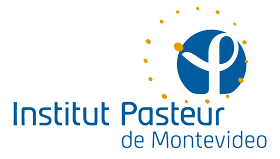Immunovirology
At the Immunovirology Laboratory, we study the cellular and molecular processes involved in leukemic transformation by oncogenic viruses. In particular, we work with the Enzootic Bovine Leukemia (LBE) caused by the Bovine Leukemia Virus (BLV), which has a high prevalence in dairy cattle, generating important economic losses for our country.
With the aim of elucidating the mechanisms involved in viral infection, we have analyzed the genetic variability of BLV in Uruguay comparing their circulating genotypes with those described in other countries. We have characterized at the molecular and structural level the main BLV proteins: the glycoprotein of envelope (ENV), capsid (CA) and protease (PR). Also, we studied the interaction between these proteins with different components of the infected cell.
Also, using transcriptomic analysis, we studied the differences of gene expression between infected and non-infected animals with BLV, to know possible mechanisms involved in the control of the infection.
The knowledge we have obtained of this pathology and its causal agent has also allowed us to develop new technologies for the diagnosis both serologically and molecularly, as well as the generation of immunogenic preparations from the viral proteins that are being tested in animal models.
The results of our work will allow us to better understand the mechanisms that cause the leukemic transformation, generating new tools to optimize its diagnosis, and new procedures to improve the control and prevention of viral transmission.
Members
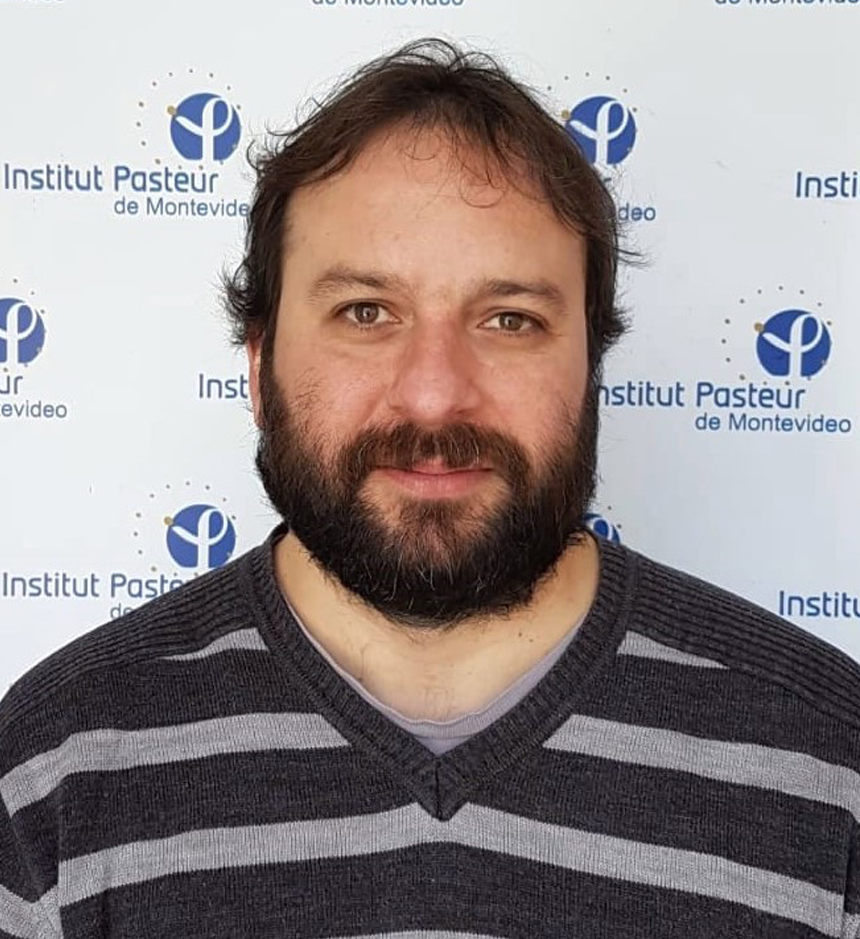
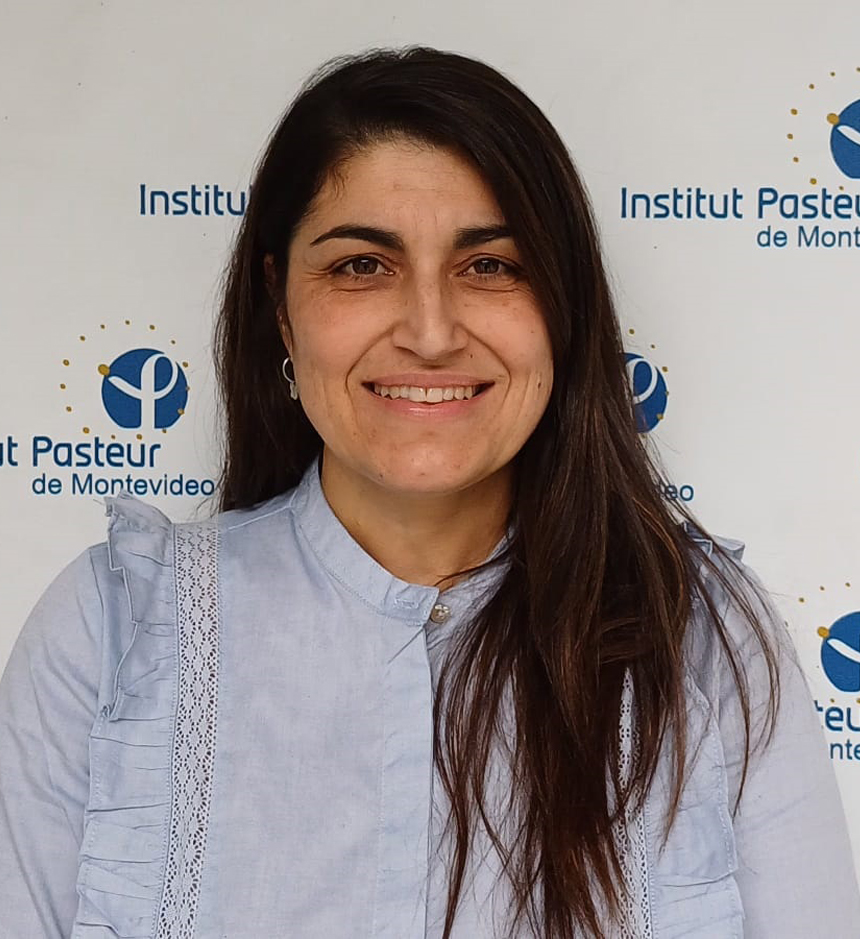
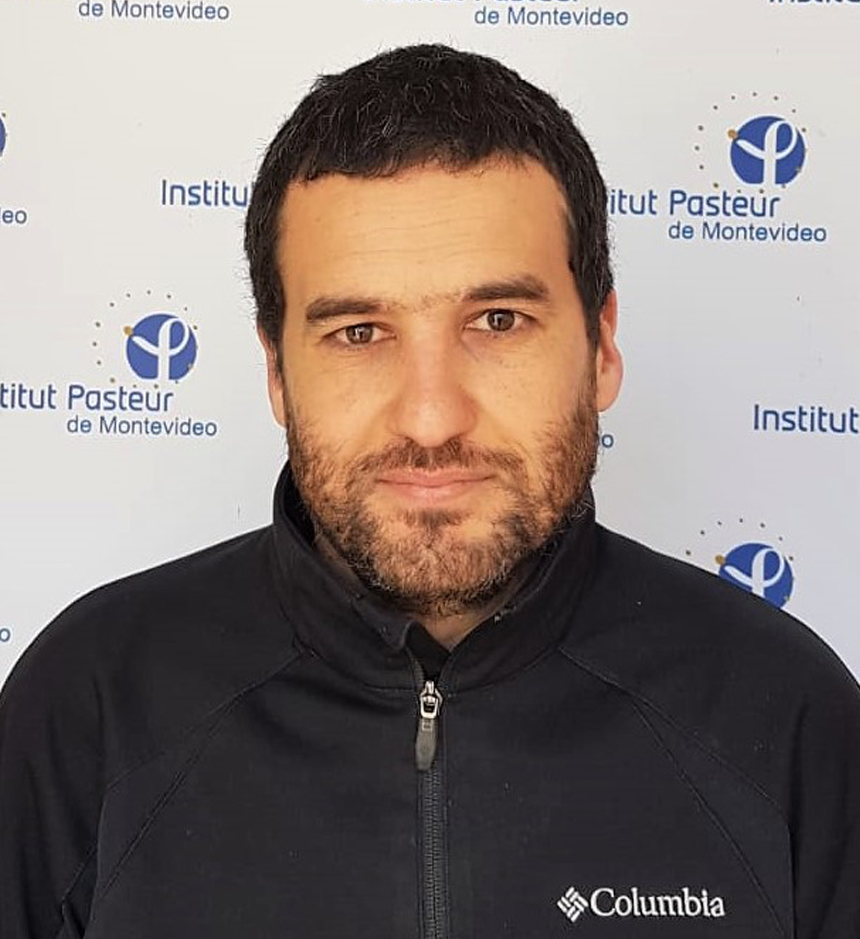
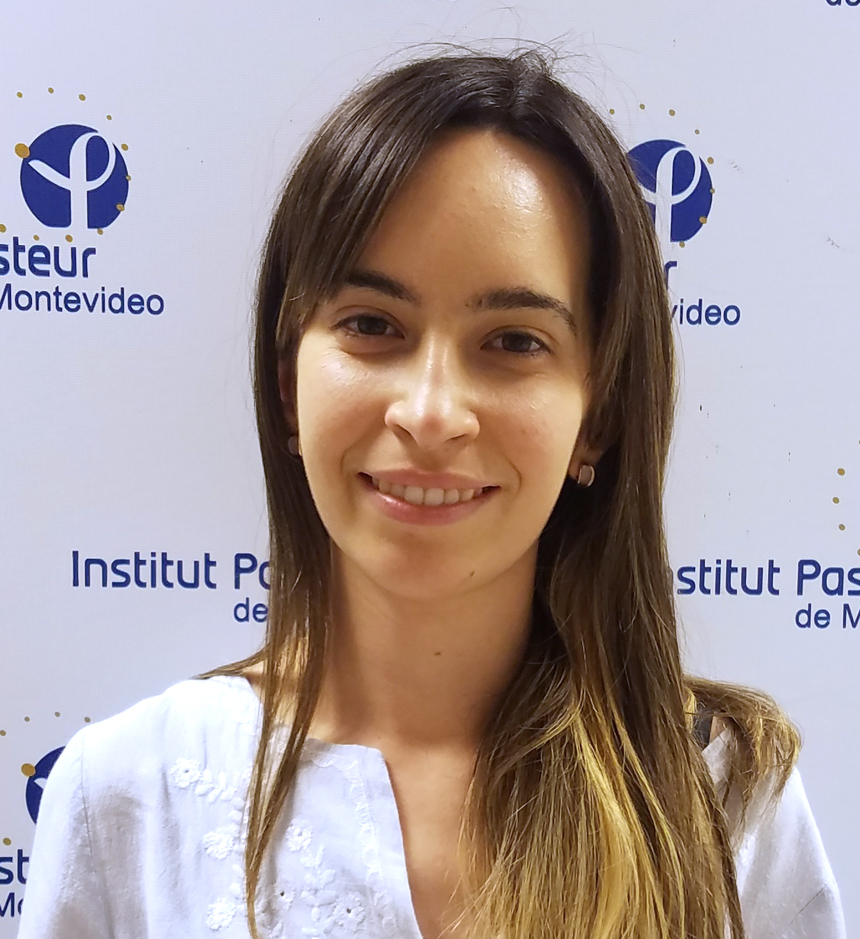
Florencia Rammauro, PhD
Honorary Senior Research Assistant
School of Medicine, Udelar
frammauro@pasteur.edu.uy
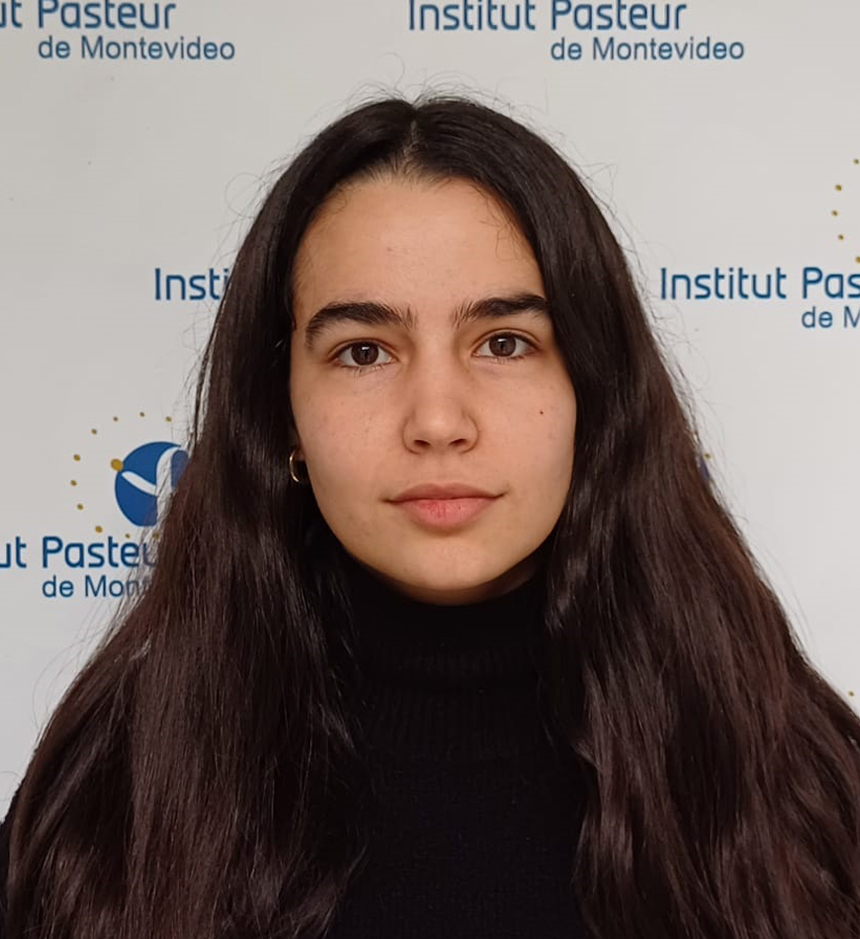
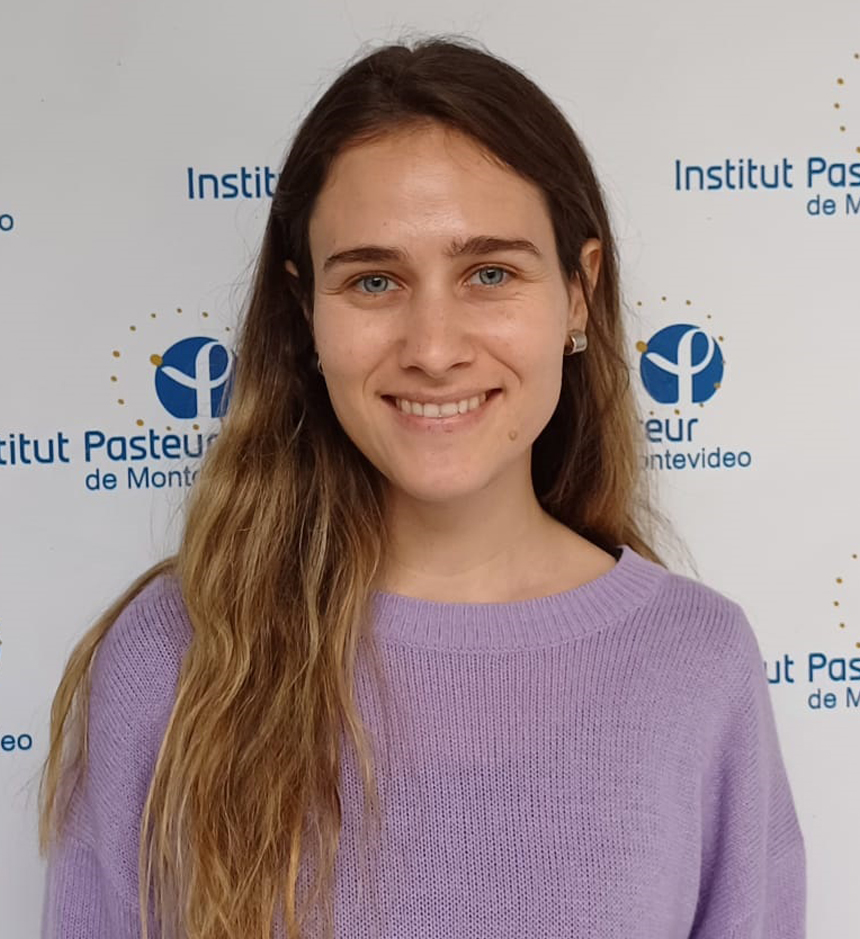
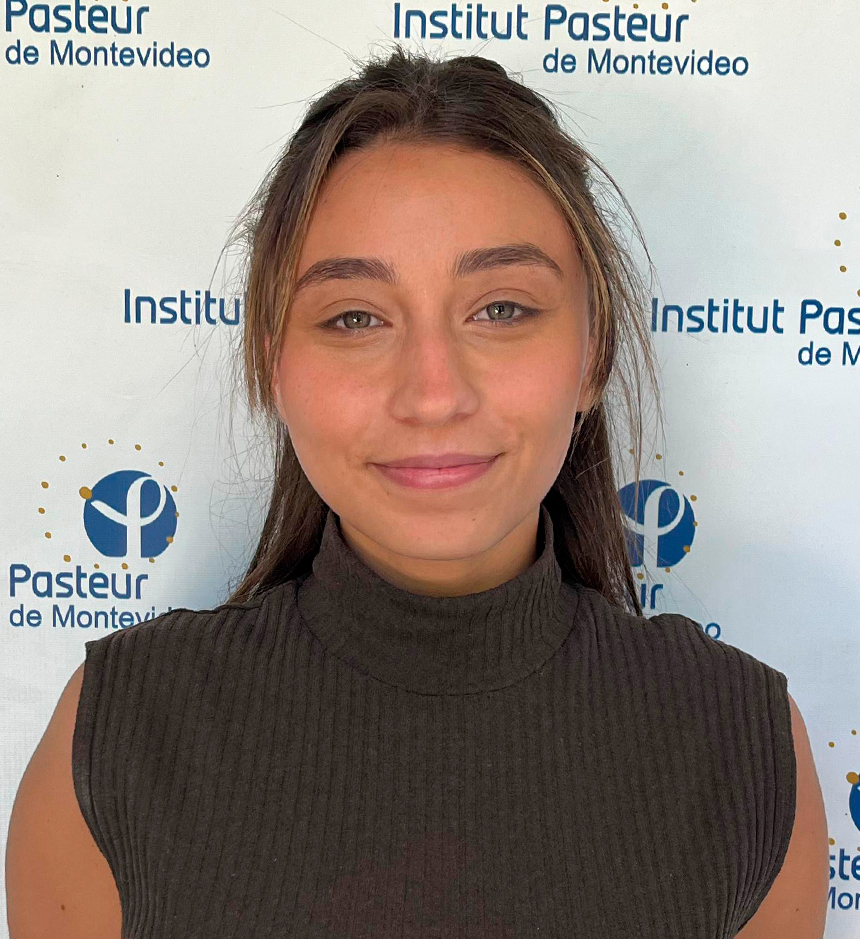
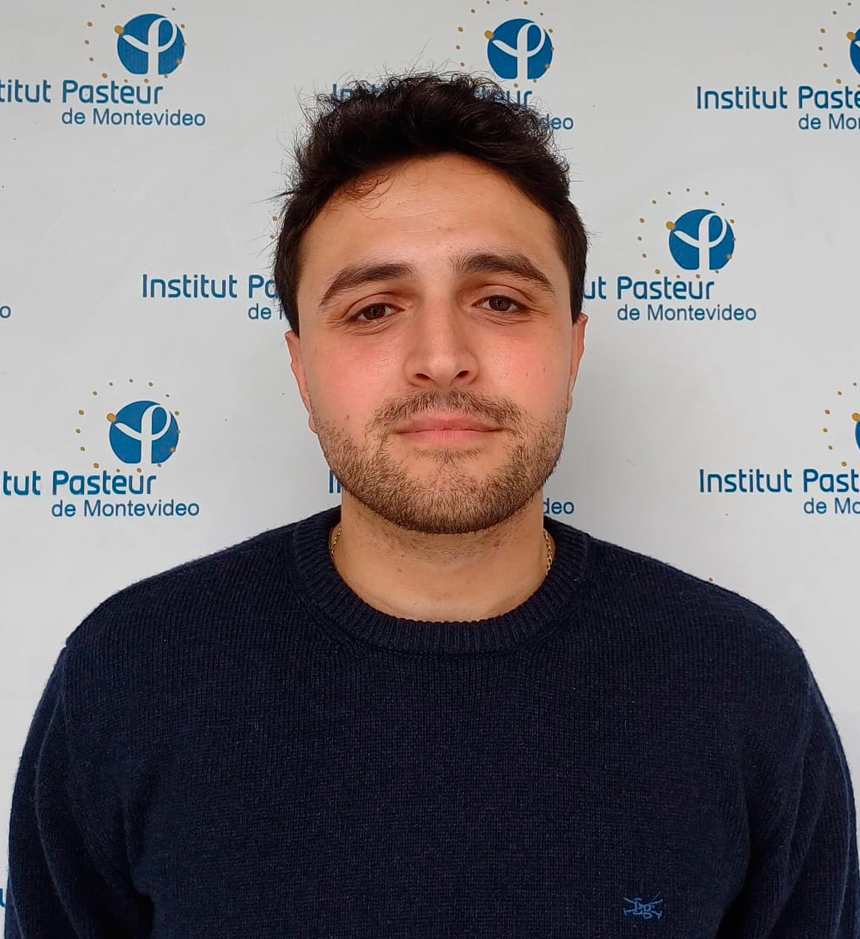
Agustin Demarco
Undergraduate student
Research lines
Biophysical and structural characterization of the BLV capsid protein (BLV-CA).
The mechanism of BLV capsid formation through the self-assembly of thousands of copies of BLV-CA represents a key event in the retrovirus cycle. To understand this mechanism we have characterized the biochemical and biophysical properties that affect this process, and in collaboration with the Laboratory of Molecular and Structural Microbiology of the IPMontevideo we elucidate the three-dimensional structure of BLV-CA, showing that it is organized in a pseudohexagonal with an important conformational plasticity. On the other hand, we generated nano-antibodies directed against the viral capsid and we studied the effect of the interaction with capsid on the modulation of self-assembly.
Characterization of the interactions between CA-VLB and intracellular components of the host cell.
The transit of the viral capsid between the plasma membrane and the cell nucleus depends on the interaction with several cellular proteins. Other retroviral models have described restriction factors that disturb the conformation of the capsid generating anti-viral conditions. For the case of delta-retroviruses such as BLV we have no confirmed evidence on these mechanisms. In the HIV model it has been demonstrated that the interaction between capsid and nucleoporins would participate in this transit and in the entrance to the nucleus through the nuclear pore. Based on the ability of BLV-CA to self-assemble in vitro in tubular or supramacromolecular structures, and using affinity and mass spectrometry techniques, our objective is to identify and characterize the interactions between BLV-CA and the factors of the cellular guest involved in this traffic. We will also look for partners of BLV-CA that can act as innate immune sensors when analyzing cell lysates of permissive and non-permissive cells to BLV infection. The engineering cells generated by Francesca Di Nunzio in IP Paris will be used to identify new restriction factors or functional viral partners by mass spectrometry. We will also design and purify nanobodies against BLV-CA that will be labeled as microscopy approaches. The results obtained in BLV will then be transferred to the HTLV-1 research to define common and diverse mechanisms adopted by these delta retroviruses when establishing the viral infection.
Biochemical, structural and immunological characterization of the BLV envelope protein.
The BLV env complex plays a crucial role in determining viral infectivity, and is responsible for inducing fusion of viral and cell membranes after recognition of specific cell surface receptors.
We have optimized the expression of the soluble env ectodomain in Drosophila S2 cells with a natural and altered furin cleavage site. We induced protein expression and secretion in the supernatant by divalent metals, and we performed protein purification by affinity chromatography using a StrepTactin column followed by size exclusion chromatography. The quality control of the proteins was evaluated by mass spectrometry. This system should allow the production of sufficient material for crystallization assays, electron cryo-microscopy of isolated trimers and biophysical studies of the multimeric complex formed by the recombinant proteins.
Env is a major target of antiviral immune responses, generating both humoral neutralizing antibodies and T-cell specific adaptive immunity. It has been reported for other retroviruses that the presence of an immunosuppressive peptide (isu) in the Env glycoprotein structure could be important in their ability to immunomodulate immune responses. We are interested in studying the effect of amino acid modifications in the isu domain on humoral and cellular adaptation responses to the challenge with modified Env glycoproteins. This will allow us to understand one of the mechanisms involved in the generation of resistance used by BLV to escape the antiviral immune response. On the other hand, we also hope to identify the modifications that reduce the immunosuppressive activity of this domain and, therefore, increase its immunogenicity. This result could be useful for the rational design of effective vaccines against this retrovirus.
Using purified BLV Env protein we have also developed a new ELISA test for use in the diagnosis of enzootic bovine leukosis. In collaboration with ATGen we are now generating a new EBL diagnostic kit that will be used in a field experiment with more than 50.000 dairy cows.
The identification of genetic traits is associated with natural control of EBL.
Given the high prevalence of EBL in Uruguay, the strategy to eradicate the disease implemented in Europe and Oceania is impracticable in our country. An alternative control strategy using vaccines is promising, but there are still no effective products on the market. Considering that recent results show that BLV has a heritable component as high as 8%, a third strategy to control the disease would involve herd breeding by increasing the frequency of genotypes associated with resistance to infection.
We have analyzed in an experimental herd with high prevalence of BLV infection, a group of animals defined as “controllers” of the disease and characterized by low proviral load and low anti-BLV antibody titers. Other groups were defined as “non-controlling” with high proviral load and high specific antibody titers, and “negative” with no detectable presence of BLV.
Using peripheral blood mononuclear cells (PBMC) from these animals, we are characterizing, in collaboration with Natalia Rego and Hugo Naya of the IPMON Bioinformatics Unit, the transcriptomic representatives of these groups by massive mRNA sequencing (mRNAseq). We hope to identify genes and isoforms differentially expressed in control animals and interpret these differences in the context of biological processes, ontologies of sub or overrepresented metabolic pathways.
Patents
- Methods for preparing human thrombopoietin polypeptides by mammalian cell cultures. Cayota A, Robello C, Pritsch O. World International Property Organization: WO0218569 (A3) 2003; USA patent: US7371569 (B2) 2008.
- An antibody specific for the Tn antigen for the treatment of cancer. Hubert-Haddad P, Amigorena S, Sastre X, Osinaga E, Pritsch O, Oppezzo P, Perez F, Moutel S. Europa: EP2014302 (A1) 2009; World International Property Organization: WO2009007222 (A1) 2009, USA patent: US20100278818 A1 2010.
Projects
2007 – 2009 – Enzootic Bovine Leukosis: control alternatives and development of new diagnostic tools. Agricultural Technology Promotion Fund (FPTA) -Instituto Nacional de Investigación Agropecuaria (INIA).
2009 – 2010 – Proteomic analysis of the Bovine Leukosis Virus. R & D project financed by CSIC.
2010 – 2011 – Contribution to the development of glycoproteomics at the Institut Pasteur Montevideo. Joint project at Institut Pasteur de Montevideo.
2011 – 2014 – Research Groups: Tumour Immunology. CSIC UdelaR.
2014 – 2017 – Identification of molecular markers associated with resistance to Bovine Leukosis Virus infection by transcriptomic analysis of individuals controlling viral load. INNOVAGRO Fund.
2015 – 2017 – Production and Characterization of Immunogens against Bovine Leukosis Virus. CSIC I+D
2014 – 2017 – Laboratoire Franco-Uruguayen de Virologie Structurale – Center National de la Recherche Scientifique (CNRS), France. Scientific officers: Otto Pritsch and Félix Rey, Unité de Virologie Structurale – CNRS URA 3015, Institut Pasteur, Paris, France.
2015 – 2018 – Determination of the proviral load of enzootic bovine leukosis (BLV) by Droplet Digital PCR and interference of the virus with the immune response against pathogens of reproductive interest. Sectoral Fund for Animal Health.
Main publications
vacio
2018
- Synthesis of hydrophilic HYNIC-[1,2,4,5]tetrazine conjugates and their use in antibody pretargeting with 99m. García MF,Gallazzi F,de Souza Junqueira M, Fernández M, Camacho X, da Silva Mororó J, Faria D, de Godoi Carneiro C, Couto M, Carrión F, Pritsch O, Chammas R, Quinn T, Cabral P, Cerecetto H. Organic & Biomolecular Chemistry 16(29):5275-5285 2018.
- A novel, smaller scaffold for Affitins: Showcase with binders specific for EpCAM. Kalichuk V, Renodon-Cornière A, Béhar G, Carrión F, Obal G, Maillasson M, Mouratou B, Préat V, Pecorari F. Biotechnol Bioeng. 2018 Feb;115(2):290-299.
2017
- Infección por virus linfotrópico de células T humanas (HTLV) en Uruguay: identificación de problemas. Balduin B, Priore C, Acosta C, Salazar E, Rodríguez F, Bianchi S, Pritsch O. Anales de Facultad de Medicina (Univ Repúb Urug) 4 (Supl 1): 41-51, 2017.
- Functional diversity of secreted cestode Kunitz proteins: Inhibition of serine peptidases and blockade of cation channels. Fló M., Margenat M., Pellizza L., Graña M., Durán R., Báez A., Salceda E., Soto E., Alvarez B., Fernández C. 2017. PLoS Pathogens. 13(2):e1006169
2016
- Effective anti-tumor therapy based on a novel antibody drug-conjugate targeting the Tn carbohydrate antigen. Sedlik C, Heitzmann A, Viel S, Ait Sarkouh R, Batisse C, Schimdt F, De La Rochere P, Amzallag N, Osinaga E, Oppezzo P, Pritsch O, Sastre-Garau X, Hubert P, Amigorena S, Piaggio E. Oncoimmunology Apr 22;5(7):e1171434, 2016.
- Comparative analysis reveals amino acids critical for the anticancer activity of peptide CIGB-552. Astrada S, Gomez Y, Barrera E, Obal G, Pritsch O, Pantano S, Vallespí MG, Bollati-Fogolín M. Journal of Peptide Science 22(11-12): 711-722, 2016.
- Regulation of signaling directionality revealed by 3D snapshots of a kinase:regulator complex in action. Trajtenberg F, Imelio JA, Machado MR, Larrieux N, Marti MA, Obal G, Mechaly AE, Buschiazzo A. Elife. 2016 Dec 12;5. pii: e21422.
- The archaeal «7 kDa DNA-binding» proteins: extended characterization of an old gifted family. Kalichuk V, Béhar G, Renodon-Cornière A, Danovski G, Obal G, Barbet J, Mouratou B, Pecorari F. Sci Rep. 2016 Nov 17;6:37274.
2015
- New potential eukaryotic substrates of the mycobacterial protein tyrosine phosphatase PtpA: hints of a bacterial modulation of macrophage bioenergetic state mitochondrial functions. Margenat M, Labandera A, Gil M, Carrión F, Purificação M, Razzera G, Portela MM, Obal G, Terenzi H, Pritsch O, Durán R, Ferreira AM, Villarino A. Scientific Reports 5: 8819: DOI: 10.1038, 2015
- Conformational plasticity of the native retroviral capsid revealed by X ray crystallography. Obal G, Trajtenberg F, Carrión F, Tomé L, Larrieux N, Zhang X, Pritsch O, Buschiazzo A. Science 349(6243):95-98, 2015.
- Inmunidad innata frente a retrovirus. González L, Ibañez N, Mateus M, Romero K, Pritsch O. Anales de Facultad de Medicina (Univ Repúb Urug) 2(Supl):18-32, 2015.
2014
- Structural characterization of a neuroblast-specific phosphorylated region of MARCKS. Tinoco LW, Fraga JL, AnoBom CD, Zolessi FR, Obal G, Toledo A, Pritsch O, Arruti C. Biochimica et Biophysica Acta – Proteins and Proteomics 1844: 837-849, 2014.
- HemR is an OmpR/PhoB-like response regulator from Leptospira, which simultaneously effects transcriptional activation and repression of key haem metabolism genes. Morero NR, Botti H, Nitta KR, Carrión F, Obal G, Picardeau M, Buschiazzo A. Mol Microbiol. 2014 Oct;94(2):340-52.
- Potent and specific inhibition of glycosidases by small artificial binding proteins (affitins). Correa A, Pacheco S, Mechaly AE, Obal G, Béhar G, Mouratou B, Oppezzo P, Alzari PM, Pecorari F. PLoS One. 2014 May 13;9(5):e97438.
- Generation of a vector suite for protein solubility screening. Correa A, Ortega C, Obal G, Alzari P, Vincentelli R, Oppezzo P. Front Microbiol. 2014 Feb 25;5:67.
2013
- Crystal structure of a human IgA1 Fab fragment at 1.55Å resolution: potential effect of the constant domains in antigen-affinity modulation. Correa A, Trajtenberg F, Obal G, Pritsch O, Dighiero G, Oppezzo P, Buschiazzo A. (PMID: 23519414) Acta Crystallografica D 69(3): 388-397, 2013.
- A detailed molecular analysis of complete Bovine Leukemia Virus genomes isolated from B-cell lymphosarcomas. Moratorio G, Fisher S, Bianchi S, Tome L, Rama G, Obal G, Carrion F, Pritsch O, Cristina J. (PMID: 23506507) Veterinary Research, 44(1): 19, 2013.
- Monoclonal antibodies toward different Tn-amino acid backbones display distinct recognition patterns on human cancer cells. Implications for effective immuno-targeting of cancer. Mazal D, Lo-Man R, Bay S, Pritsch O, Dériaud E, Ganneau C, Medeiros A, Ubillos L, Obal G, Berois N, Bolatti-Fogolin M, Leclerc C, Osinaga E. (PMID: 23604173) Cancer Immunology and Immunotherapy 62: 1107-1122, 2013
- Avances en el conocimiento de la vaca lechera durante el período de transición en Uruguay: un enfoque multidisciplinario. Meikle A, Cavestany D, Carriquiry M, Adrien ML, Artegoitia V, Pereira I, Ruprechter G, Pessina P, Rama G, Fernandez A, Breijo M, Laborde D, Pritsch O, Ramos JM, de Torres E, Nicolini P, Mendoza A, Dutour J, Fajardo M, Astessiano AL, Olazábal L, Mattiauda D, Chilibroste P. Agrociencia Uruguay 17(1): 141-152, 2013.
2012
- Análisis del descenso de anticuerpos en el periparto y su impacto en el diagnóstico serológico de la Leucosis Bovina. Rama G, Pritsch O, Adrien ML, Moratorio G, Meikle A. Veterinaria (Montevideo) 48(185): 11–17 2012.
- Search for an aetiological virus candidate in chronic lymphocytic leukaemia by extensive transcriptome analysis. Rego N, Bianchi S, Moreno P, Persson H, Kvist A, Pena A, Oppezzo P, Naya H, Rovira C, Dighiero G, Pritsch O. (PMID: 22489537) British Journal of Haematology 157(6):709-17, 2012.
- The crystal structure of the MAP kinase LmaMPK10 from Leishmania major reveals parasite-specific features and regulatory mechanisms. Horjales S, Schmidt-Arras D, Limardo RR, Leclercq O, Obal G, Prina E, Turjanski AG, Späth GF, Buschiazzo A. Structure. 2012 Oct 10;20(10):1649-60.
- Characterisation of the native lipid moiety of Echinococcus granulosus antigen B. Obal G, Ramos AL, Silva V, Lima A, Batthyany C, Bessio MI, Ferreira F, Salinas G, Ferreira AM. PLoS Negl Trop Dis. 2012;6(5):e1642
2011
- Serine / threonine protein kinase PrkA of Listeria monocytogenes: biochemical characterization and identification of interacting partners through proteomic approaches. Lima A, Durán R, Schujman G, Marchissio MJ, Portela MM, Obal G, Pritsch O, de Mendoza D, Cerveñansky C. (PMID:21406257) Journal of Proteomics 74(9):1720-34, 2011.
- Tools to evaluate the conformation of protein products. Manta B, Obal G, Ricciardi A, Pritsch O and Denicola A. (PMID: 21570497) Biotechnology Journal 6(6): 731-741, 2011.
- Crystal structure of an enzymatically inactive trans-sialidase-like lectin from Trypanosoma cruzi: The carbohydrate binding mechanism involves residual sialidase activity. Oppezzo P, Obal G, Baráibar M, Pritsch O, Alzari PM, Buschiazzo A. (PMID: 21570497) Biochimica et Biophysica Acta 1814(9): 1154-1161, 2011.
- Antibody-dependent cell cytotoxicity synapses form in mice during tumor-specific antibody immunotherapy. Hubert P, Heitzmann A, Viel S, Nicolas A, Sastre-Garau X, Oppezzo P, Pritsch O, Osinaga E, Amigorena S. (PMID: 21697279) Cancer Research 71(15):5134-5143, 2011.
- Competitive selection from single domain antibody libraries allows isolation of high-affinity antihapten antibodies that are not favored in the llama immune response. Tabares-da Rosa S, Rossotti M, Carleiza C, Carrión F, Pritsch O, Ahn KC, Last JA, Hammock BD, González-Sapienza G. (PMID: 21827167) Analytical Chemistry 83(18):7213-7220, 2011.
2010
- Phylogenetic analysis of bovine leukemia viruses isolated in South America reveals diversification in seven distinct genotypes. Moratorio G, Obal G, Dubra A, Correa A, Bianchi S, Buschiazzo A, Cristina J, Pritsch O. Archives of Virology 155(4):481-9. 2010.
- High expression of AID and active class switch recombination might accounts for a more aggressive disease in unmutated CLL patients: link with an activated microenvironment in CLL disease. Palacios F, Moreno P, Morande PE, Abreu C, Correa A, Porro V, Landoni AI, Gabus R, Giordano M, Dighiero G, Pritsch O, Oppezzo P. Blood 115 (22): 4488-4496, 2010.
- Immunoglobulin heavy chain V-D-J gene rearrangement and mutational status in Uruguayan patients with chronic lymphocytic leukemia. Bianchi S, Moreno P, Landoni AI, Naya H, Oppezzo P, Dighiero G, Gabús R, Pritsch O. (PMID: 20929321) Leukemia & Lymphoma 51 (11): 2070-2078, 2010.
- Estudio comparativo de tres técnicas diagnósticas para la Leucosis Enzoótica Bovina y análisis del efecto de enfermedades concurrentes sobre la fórmula leucocitaria. Rama G, ,Meikle A ,Puentes R, Moratorio G, Nicolini P, Pessina P, Furtado A, Pritsch O. Veterinaria (Montevideo) 46: 15-22, 2010.
- Bioinorganic chemistry of Parkinson´s disease: Structural determinants for the copper-mediated amyloid formation of alpha-synuclein. Binolfi A, Rodrigues Mendéz EE, Valensin D, D´Amelio N, Ipolitti E, Obal G, Duran R, Magistrato A, Pritsch O, Zweckstetter M, Valensin G, Carloni P, Quintanar L, Griesinger C, Fernández CO. (PMID: 20964419) Inorganic Chemistry 49 (22): 10668-10679, 2010.
2009
- Use of diaminofluoresceins to detect and measure nitric oxide in low level generating human immune cells. Tiscornia A, Cairoli E, Marquez M, Denicola A, Pritsch O, Cayota A. Journal of Immunological Methods 342(1-2):49-57, 2009.
- A global benchmark study using affinity-based biosensors. Rich RL, Papalia GA, Flynn PJ, Furneisen J, Quinn J, Klein JS, Katsamba PS, Waddell MB, Scott M, Thompson J, Berlier J, Corry S, Baltzinger M, Zeder-Lutz G, Schoenemann A, Clabbers A, Wieckowski S, Murphy MM, Page P, Ryan TE, Duffner J, Ganguly T, Corbin J, Gautam S, Anderluh G, Bavdek A, Reichmann D, Yadav SP, Hommema E, Pol E, Drake A, Klakamp S, Chapman T, Kernaghan D, Miller K, Schuman J, Lindquist K, Herlihy K, Murphy MB, Bohnsack R, Andrien B, Brandani P, Terwey D, Millican R, Darling RJ, Wang L, Carter Q, Dotzlaf J, Lopez-Sagaseta J, Campbell I, Torreri P, Hoos S, England P, Liu Y, Abdiche Y, Malashock D, Pinkerton A, Wong M, Lafer E, Hinck C, Thompson K, Primo CD, Joyce A, Brooks J, Torta F, Bagge Hagel AB, Krarup J, Pass J, Ferreira M, Shikov S, Mikolajczyk M, Abe Y, Barbato G, Giannetti AM, Krishnamoorthy G, Beusink B, Satpaev D, Tsang T, Fang E, Partridge J, Brohawn S, Horn J, Pritsch O, Obal G, Nilapwar S, Busby B, Gutierrez-Sanchez G, Gupta RD, Canepa S, Witte K, Nikolovska-Coleska Z, Cho YH, D’Agata R, Schlick K, Calvert R, Munoz EM, Hernaiz MJ, Bravman T, Dines M, Yang MH, Puskas A, Boni E, Li J, Wear M, Grinberg A, Baardsnes J, Dolezal O, Gainey M, Anderson H, Peng J, Lewis M, Spies P, Trinh Q, Bibikov S, Raymond J, Yousef M, Chandrasekaran V, Feng Y, Emerick A, Mundodo S, Guimaraes R, McGirr K, Li YJ, Hughes H, Mantz H, Skrabana R, Witmer M, Ballard J, Martin L, Skladal P, Korza G, Laird-Offringa I, Lee CS, Khadir A, Podlaski F, Neuner P, Rothacker J, Rafique A, Dankbar N, Kainz P, Gedig E, Vuyisich M, Boozer C, Ly N, Toews M, Uren A, Kalyuzhniy O, Lewis K, Chomey E, Pak BJ, Myszka DG. Analytical Biochemistry 386(2):194-216, 2009.
2008
- Small RNAs analysis in CLL reveals a deregulation of miRNA expression and novel miRNA candidates of putative relevance in CLL pathogenesis. Marton S, Garcia MR, Robello C, Persson H, Trajtenberg F, Pritsch O, Rovira C, Naya H, Dighiero G, Cayota A. Leukemia 22: 330-338, 2008.
- HIV-1 induced decrease of nitric oxide production and inducible nitric oxide synthase expression during in vivo and in vitro infection. Cairoli E, Scott-Algara D, Pritsch O, Dighiero G and Cayota A. Clinical Immunology 127: 26-33, 2008.
- High throughput method for ranking the affinity of peptide ligands selected from phage display libraries. González-Techera A., Cardozo S., Obal G., Pritsch O., Last J., Gee S., Hammock and González-Sapienza G. Bioconjugate Chemistry 19: 993-1000, 2008
- Regulation of glutamate metabolism by protein kinases in mycobacteria. O’Hare HM, Durán R, Cerveñansky C, Bellinzoni M, Wehenkel AM, Pritsch O, Obal G, Baumgartner J, Vialaret J, Alzari PM, Johnsson K. Molecular Microbiology, 70(6): 1408-1423, 2008.
